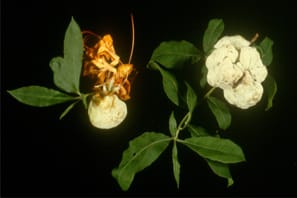
Leaf galls
Azalea leaf gall, caused by the fungus Exobasidium vaccinii, are common on azalea in the spring during wet, humid, cooler weather.
The fungus invades expanding leaf and flower buds causing these tissues to swell and become fleshy, bladder-like galls. Initially, the galls are pale green to pinkish. Eventually, they become covered with a whitish mold-like growth. Fungal spores are produced within the white growth and are spread by water-splashing or wind to other expanding leaf or flower buds, or they adhere to newly formed buds, over-winter, and infect these buds the following spring. Older leaves and flowers are immune to infection. As the galls age, they turn brown and hard.
The disease does not cause significant damage to affected plants. It just looks unsightly.
Azalea leaf gall can be prevented in subsequent years by removing the galls by hand as soon as they are detected and destroying them before they turn white and release spores. Fungicides are generally not needed or recommended for control of this disease.
For more information on azaleas, see the UGA publication Selecting and Growing Azaleas.
